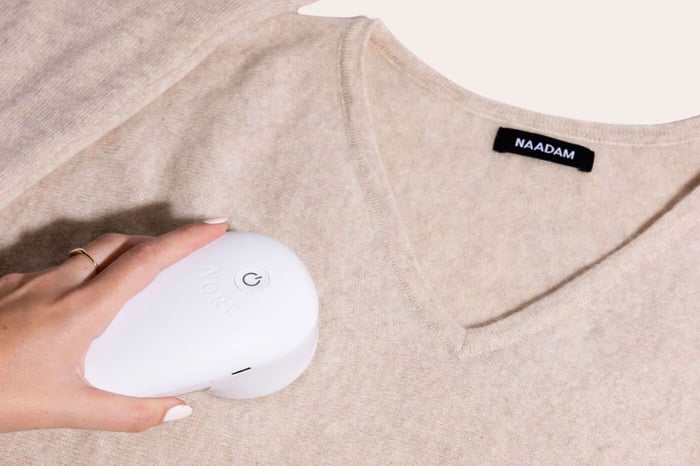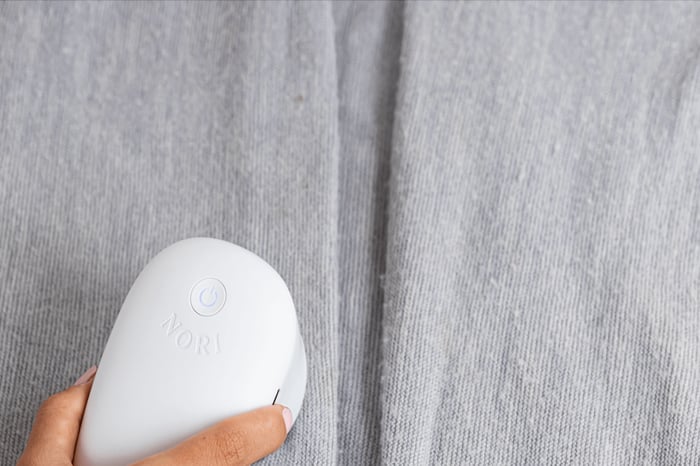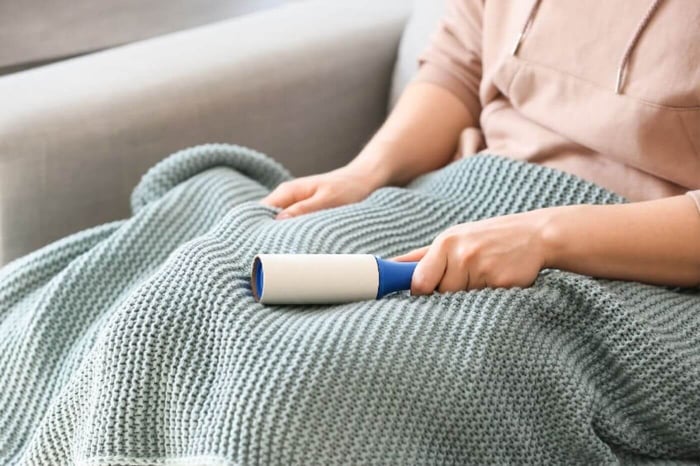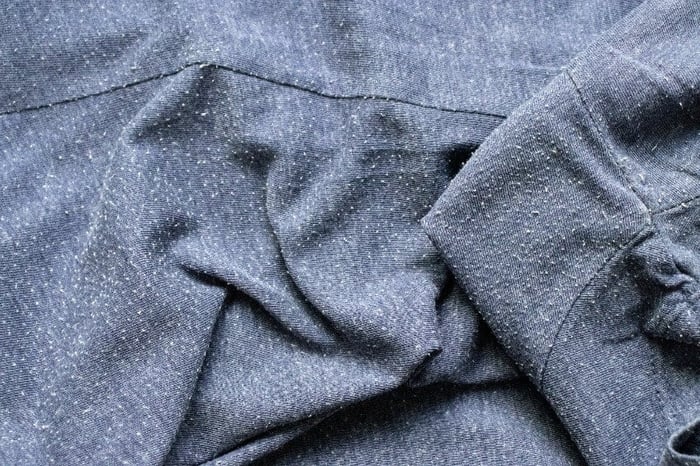
Cashmere is a luxurious and elegant material, but cashmere garments can be difficult to care for. If you’re not careful with cashmere clothing, it can easily start pilling - those tiny little balls of fuzz that make your clothes look old and worn out. But don’t worry! In this article, we’ll cover everything you need to know about how to keep cashmere from pilling so that your favorite sweaters stay looking fresh and new no matter how often they get worn or washed.
We’ll also go over the best practices for caring for cashmere garments, such as using the Nori Press, as well as some alternatives if you want something less delicate than traditional wool fabrics like cashmere. So read on if you want to learn all there is to know about keeping your cashmere pill-free!
Attention: Use discount code “SHOP10” at checkout to save 10% on The Nori Trim!
What is Pilling?
Pilling is a common problem with cashmere clothing, but it doesn’t have to be. Pilling occurs when the fibers of your garment become tangled and form small balls on the surface of the fabric. It can make your clothes look worn out and unattractive.
-
Definition of Pilling: Pilling is a condition in which tiny balls or “pills” form on the surface of fabrics due to abrasion from wear, washing, or dry cleaning. The pills are made up of loose fibers that have been twisted together by friction caused by the movement against other surfaces such as skin or furniture. Cashmere pills are the small balls of tangled fibers that form on the surface of cashmere garments due to friction.
-
Causes of Pilling: Cashmere pilling is caused primarily by friction between two surfaces such as skin and fabric, or fabric and furniture. Other causes include improper laundering techniques like using too much detergent or not rinsing thoroughly enough after washing; wearing tight-fitting garments; rubbing against rough surfaces; storing items improperly; and age (older garments may pill more easily).
If you notice any small fuzzballs forming on your cashmere clothing, this could be an indication that pilling has begun. Additionally, loose threads sticking out from the fabric or roughness when running your hand over the garment’s surface may also signify early stages of pilling occurring underneath the surface layers. Therefore, it is important to address these signs promptly to prevent further pilling.
Pilling is a common problem that affects many types of fabrics, but it can be especially noticeable in cashmere. Knowing what pilling is and the causes behind it are important steps to take when trying to prevent or remove pilling from your clothes. Let’s now look at how to keep cashmere from pilling.
How to Prevent Cashmere From Pilling
-
Washing Tips: Cashmere is a delicate fabric and should be washed with care. Hand-washing is the best way to prevent cashmere pilling, as it will help prevent friction between the fibers. Use cold water and a mild detergent specifically designed for wool or cashmere, such as Woolite. Do not use bleach or harsh chemicals on your cashmere garments. Gently agitate the garment in soapy water and rinse until all of the soap has been removed. After washing, lay flat to dry away from direct sunlight or heat sources.
-
Storage Tips: To prevent pilling on your cashmere clothes, proper storage is key! Store them in an airtight container when not being worn to protect them from dust and dirt particles that can cause friction between fibers leading to pilling. It’s also important to store them away from other fabrics that may rub against each other causing wear and tear over time which can lead to pilling too!
When wearing cashmere clothing, it is best to avoid wearing it more than once before laundering in order to reduce any potential damage caused by sweat or body oils that could lead to pilling over time. Additionally, jewelry made of metal should be avoided around the neckline as these items can snag on delicate fibers and cause premature wear and tear resulting in pills forming faster than normal.
By following these simple tips, you can keep your cashmere looking great and free from pilling. Now let’s look at how to remove pilling from your clothes if it does occur.
How to Remove Pills from Cashmere Clothes Using a Cashmere Comb
It occurs when the delicate fibers of the fabric become matted and tangled, forming small balls on the surface of the garment. Fortunately, there are ways how to keep cashmere from pilling without damaging them.
-
Hand-Removal Methods: Hand-removal methods involve using your fingers or tools such as tweezers or scissors to gently pull off any pills that have formed on your cashmere clothing. This method is best for removing smaller pills that are not too deeply embedded in the fabric. Start by laying out your garment flat and carefully picking off each pill one at a time until all visible pills have been removed. If you’re having trouble getting rid of stubborn pills, try using tweezers or scissors to help get them out more easily. Another effective tool for removing pills is a cashmere comb. Gently running the comb over the surface of the garment can help remove pills without damaging the delicate fibers.

-
Machine Methods: Machine-removal methods involve using a fabric shaver specifically designed for de-pilling garments such as sweaters and coats made from wool, cotton, and other fabrics including cashmere. To use this method, lay the garment flat on a hard surface before running the electric razor over it in short strokes while holding it at an angle so that only one side of its blades makes contact with the fabric at any given time. This will ensure even coverage without causing damage to your clothing item’s fibers or stitching. Alternatively, a sweater stone can be used to gently remove pills from cashmere garments, thanks to its naturally rough-textured surface. Afterward, brush away any remaining lint with a soft cloth before wearing it again.
Best Practices for Caring for Cashmere Clothes
To ensure your cashmere clothes last for years, it’s important to understand the best practices for caring for them. Here are some tips on washing, drying, and storing cashmere clothing.
Washing and Drying Tips:
-
Cashmere should be washed by hand or in a machine with cold water on a gentle cycle using a mild detergent specifically designed for delicates such as wool or cashmere. When washing, be gentle to avoid agitating the cashmere fibres, which can lead to pilling. Avoid wringing out your garment after washing; instead, press out excess water with a towel before laying flat to dry away from direct sunlight or heat sources. If you choose to use the dryer, select the lowest setting available as high temperatures can cause shrinkage of up to 20%. When drying items made of pure cashmere, always lay them flat so they don’t lose their shape over time.
-
Before storing your garments away during off-seasons, make sure they are completely clean and free of any dirt or debris that could damage them. Place each item in an airtight container lined with acid-free tissue paper before placing it in storage; this will help protect against dust mites which can cause discoloration over time if left unchecked. It is also important not to hang your garments when storing as this may stretch them out of shape due to gravity pulling down on them constantly while hung up vertically rather than horizontally when laid flat, as recommended after the wash/dry cycle(s).
By following these best practices for caring for cashmere clothes, you can help to prevent pilling and extend the life of your favorite garments. Now let’s look at some tips on how to remove pilling from cashmere clothing.
 Key Takeaway: Cashmere is a luxurious and delicate fabric that requires special care to maintain its softness and beauty. To keep your cashmere from pilling, it’s important to follow these key steps:
Key Takeaway: Cashmere is a luxurious and delicate fabric that requires special care to maintain its softness and beauty. To keep your cashmere from pilling, it’s important to follow these key steps:
1. Wash by hand or on a gentle cycle with cold water using a mild detergent for delicates such as wool or cashmere.
2. Avoid wringing out the garment after washing; press out excess water with a towel before laying flat to dry away from direct sunlight heat sources.
3. If using the dryer, select the lowest setting available as high temperatures can cause shrinkage of up to 20%.
4. When drying items made of pure cashmere, always lay them flat so they don’t lose their shape over time.
5. Before storing away during off-seasons, make sure garments are clean and free of any dirt debris that could damage them; store in an airtight container lined with acid-free tissue paper before placing it in storage to protect against dust mites which can cause discoloration over time if left unchecked (and avoid hanging).
Alternatives to Cashmere Clothing
When it comes to finding alternatives to cashmere clothing, there are two main types of fabrics that you can choose from synthetic fibers and natural fibers.
Synthetic fibers are man-made materials created in a laboratory or factory setting. Examples include polyester, nylon, acrylic, spandex, and rayon. These fabrics tend to be more affordable than natural fiber options and often offer greater durability as well as resistance to wrinkles and fading.
Natural fibers come from plants or animals such as cotton, wool, silk, linen, hemp, bamboo viscose (rayon), alpaca wool, and angora rabbit hair. Natural fabrics are usually softer than synthetics but may require more care when washing or storing them due to their delicate nature. They also tend to be more expensive than synthetic options because they're not mass-produced like synthetics are.
-
Cotton is one of the most popular natural fabric choices for clothing due to its breathability which makes it comfortable for hot days while still providing some warmth on cooler days. It's also relatively easy to care for since it can be machine washed with cold water on a gentle cycle and then tumble dried on low heat settings if needed after air drying first if possible. Cotton is generally very durable so it should last through many washes without losing its shape or color too quickly compared with other fabrics like cashmere which tends to pill easily over time when worn frequently.
-
Linen is another great alternative fabric choice made from flax plant fibers that offer excellent breathability making it ideal for warm weather wear although the loose weave structure means that this fabric may wrinkle easily during wear so you might need an iron afterward depending on how wrinkled your garment gets during wear. This material is also quite strong despite being lightweight so should last through multiple wears before needing replacing, unlike cashmere which pills quickly when worn regularly.
-
Hemp is an excellent eco-friendly alternative fabric choice since it requires little water usage in production compared to other materials such as cotton. Additionally, hemp fibers have naturally antibacterial properties, meaning they do not need chemical treatments like other fabrics during manufacturing processes. Hemp garments provide comfort and durability, making them perfect replacements for cashmere items that pill quickly after regular use.
For those looking for a more affordable and durable option to cashmere, there are plenty of alternatives available. From synthetic fibers to natural fibers, the options are endless! Let's now look at how to prevent pilling on cashmere clothing.
 Key Takeaway: When it comes to finding alternatives to cashmere clothing, there are two main types of fabrics that you can choose from synthetic fibers and natural fibers. Natural fibers like cotton, linen, and hemp offer breathability, durability, and resistance to pilling compared with cashmere. Hemp is a particularly good choice as it's eco-friendly and has natural antibacterial properties.
Key Takeaway: When it comes to finding alternatives to cashmere clothing, there are two main types of fabrics that you can choose from synthetic fibers and natural fibers. Natural fibers like cotton, linen, and hemp offer breathability, durability, and resistance to pilling compared with cashmere. Hemp is a particularly good choice as it's eco-friendly and has natural antibacterial properties.
Attention: Use discount code "SHOP10" at checkout to save 10% on The Nori Trim!
FAQs in Relation to How to Keep Cashmere From Pilling
Why does cashmere pill so much?
Cashmere is a delicate fabric made from the wool of goats. It is prized for its softness and warmth, but it also has a tendency to pill. Pilling occurs when short fibers in the material break off and form small balls on the surface of the garment. This happens because cashmere fibers are shorter than other fabrics like cotton or polyester, making them more prone to breaking away from the weave over time with wear and washing.
Additionally, friction caused by rubbing against skin or other surfaces can cause pilling as well.
How do I stop pilling cashmere?
Wondering how to keep cashmere from pilling? Start by washing it with mild detergent in cold water. Turn the garment inside out and use a gentle cycle to avoid agitating the fabric too much. When drying, lay flat or hang dry instead of using a machine dryer. Additionally, store your cashmere away from direct sunlight and other heat sources to keep it looking its best for longer. To remove existing pills, try using an electric fabric shaver or even just a simple razor. Gently run either tool over the surface of the garment to remove any fuzz balls without damaging the material underneath.
Does cashmere eventually stop pilling?
Yes, cashmere will eventually stop pilling. Cashmere is a delicate fabric that can be prone to pilling due to its natural fibers and the friction created when it rubs against other surfaces or fabrics. However, with proper care and maintenance, cashmere can last for years without developing any pills. Regularly brushing your garments with a soft brush or comb helps remove loose fibers before they form into pills. Additionally, washing your clothes in cold water on gentle cycles and air drying them will help keep them looking new longer and reduce the chances of pilling occurring.
Is cashmere pilling normal?
Yes, pilling on cashmere is normal. Pilling occurs when fibers in the fabric rub together and form small balls of tangled fiber. This is a common occurrence with fabrics that contain high levels of natural fibers such as wool or cashmere.
The best way to prevent pilling from occurring is to avoid rubbing the fabric against itself and other surfaces and washing it according to the instructions on the label. If pilling does occur, there are several methods for removing it including using a lint roller or an electric pill remover device.
Conclusion
When it comes to cashmere, proper care is essential for keeping your clothes looking their best. By following the tips on how to keep cashmere from pilling, you can keep cashmere from pilling and extend its life. Remember to hand wash or dry clean your garments, avoid friction when wearing them, store them properly, and use a lint roller regularly. With these simple steps, you can ensure that your cashmere clothing looks great for years to come!
If you have cashmere clothing, then it's time to take the necessary steps to keep your beloved pieces looking their best. Pilling is a common issue with cashmere and other fabrics that can easily ruin an otherwise beautiful garment.
Fortunately, there are ways of preventing pilling before it starts as well as solutions for removing existing pills from fabric. Take action today on how to keep cashmere from pilling and learn how easy it is to restore them if needed. Buy the Nori Trim today!








